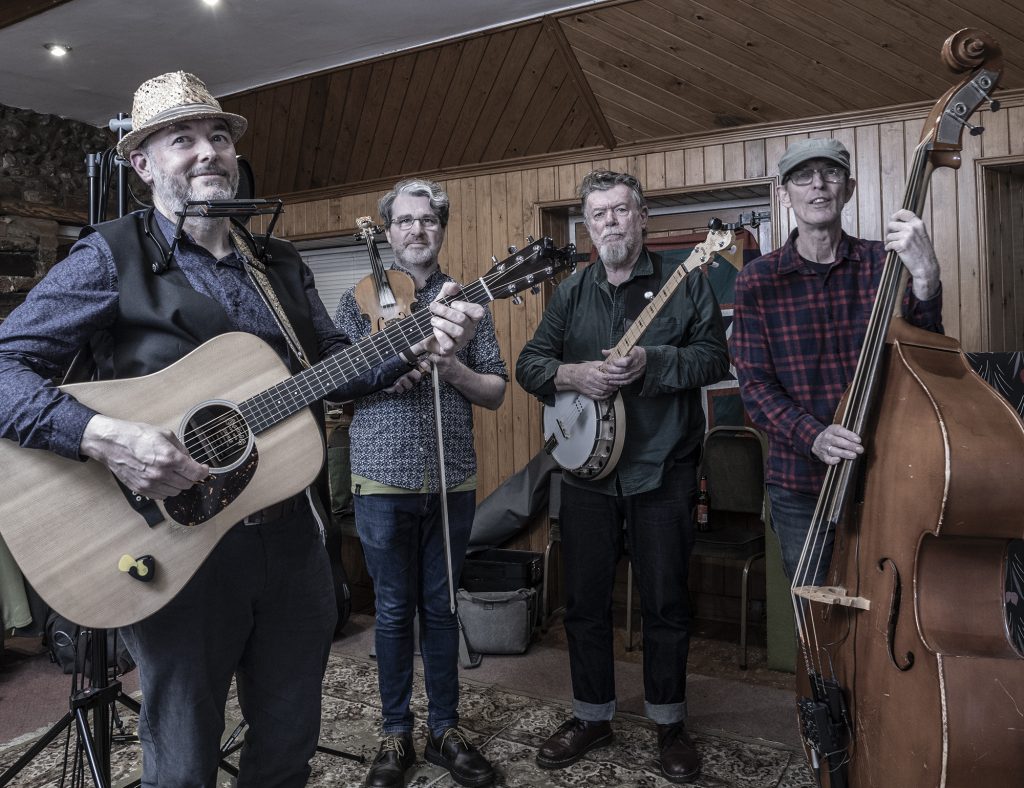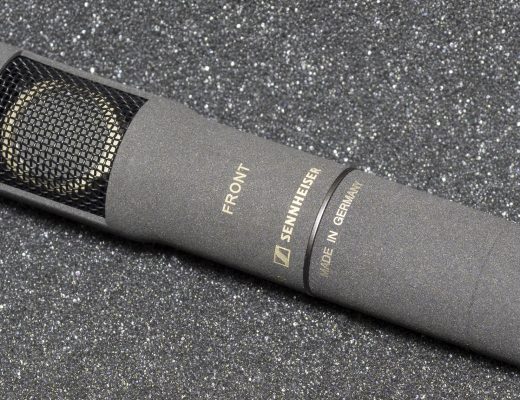
Thursday evening was an inauspicious time to be heading out for a recording of a bluegrass band: it was a soggy wet evening here in rural Norfolk, with the narrow roads full of potholes lurking below rivers. It didn’t feel much like the Appalachian Mountains. Was it left, right, left, right, left and right again on the maze of roads around Mannington and Wolterton, or the other way round? And if I didn’t remember my left from my right, how on earth would I remember how to connect up the mics for some more mid-side recordings, building on my earlier comparative tests of the new Sennheiser MKH 8030?
I was heading back to The Forge, the studio of Kev Burton, where, a few months ago, I recorded Lucy Grubb and her band using a Blumlein pair of Rycote BD-10 fig 8 mics. This time it was a similar venture: a different band (albeit with the common factor of Kev on bass) – the Time and Mercy Band – and with a mid-side pair instead of a Blumlein pair. This was partly driven by only having a single pre-production Sennheiser MKH 8030 fig 8, but, also, because I wanted to test further the MKH 8030 in combination with the MKH 8040 cardioid as the mid mic, and throw the new Rycote BD-10 fig 8 and its cardioid (CA-08) sibling into the mix. Back at base, I’d decided that to compare the four mics in a mid-side array and allow any combination (but always using an immediately adjacent pair as mid and side mics), I needed a vertical array of five mics: that was BD-10 top and bottom, MKH 8030 in the middle, and the two cardioids between the three fig 8s. Getting them close together (I managed 4mm apart, which is better than many a back-to-back clip) was tricky and meant I couldn’t use individual shock mounts: but still wanting some isolation from a wooden floor and anticipated tapping feet, I then bolted the whole array to a pair of hefty (Duo Lyre 68 shore) Rycote Invision shock mounts, and, for belt and braces, put the stand on foam pads.

It was a little easier setting up than with the Blumlein recording, this time having all the musicians on one side of the mics and having no drum kit to manage in a fairly compact studio, but the principle remained very much as before – needing care to balance the different instruments and voices – for which having the studio’s control room, with its wonderful Midas desk (originally made for Frank Zappa) feeding into Logic, and Kev’s experience with it, was invaluable for reviewing each take. The primary feed from the mics was, again, to my field recorder.
We recorded three songs, but, for the purposes of this post I am going to focus on one, which the band call ‘Sugar Honey Babe’. It’s a traditional bluegrass song and has been recorded with many similar titles (and, of course, variations in the lyrics), and perhaps is most well-known nowadays as ‘Red Rocking Chair’.
OK, that’s more than enough preamble: to the results! First off, here’s a very quick and dirty video: one camera stuck on a tripod pointing towards the band and with the mics largely blocking the view of Rob on banjo. My excuse is that the focus was on the audio. The video switches between the various mic combinations and, as the previous tests showed that the two Rycotes are lighter in the bass department than their MKH 8000 series counterparts, a few options where the BD-10 and the CA-08 have some EQ: imperfectly applied, no doubt, but it reduces some of the more obvious differences between the mics. Other than the EQ on these few clearly labelled snippets, all the sound is as it was recorded: no reverb, no compression etc.
For those wanting to listen to the sound files without whatever YouTube does to them, here they are. I’ve not included the EQ’d versions as I am sure others can do better, or would at least want to try. These LR stereo files can, of course, be decoded back to the original mid and side channels, should you so wish (I’ve enabled downloading permissions on SoundCloud for them).
I’m not sure all the versions of the tracks with the Rycote mics given some EQ (as used where flagged up in the video above) merit inclusion, but here is just the one – the recording with the MKH 8040 and the EQ’d BD-10: although the EQ is fairly rough and ready, it does show the potential, should you wish it, to bring the mic nearer the MKH 8030.
And, finally, for a bit of fun, here’s a version of the video with the MKH 8040 and MKH 8030 pair throughout, rather than chopping and changing mic pairs. I’ve added a little reverb to this version.
So the verdict this time? As with the Blumlein pair recording, that’s one for others perhaps. The balance of the recording is far from perfect: we didn’t have endless time to fiddle around with placement, and, even if we had spent hours on it, it would have been hard to balance, say, Rob’s backing vocal and his (much louder) banjo. On a different note, rain can be heard on the studio window too: so not ideal. But putting the MKH 8030 into more real-world action with a largely acoustic band (there was a little bit of amplification for the bass) was useful, not least seeing how it performed with the MKH 8040 and just how much difference was noticeable when swapping out to different (and less expensive) mics, and what a bit of EQ might do to that. As before, my take is that the MKH 8030 is a first-rate mic, pairs well with the excellent MKH 8040 (as entirely expected), but that the considerably cheaper BD-10 is decent too and that, with some EQ, comes much closer to the MKH 8030 – especially when used as the side mic in a mid-side recording. As I’ve said before, it’s good to have these two new choices in the limited field of SDC fig 8 mics: happy days!




1 Comment
[…] Part 2 of the Sennheiser MKH 8030 (fig 8) tests involved recording a bluegrass band with a mid-side set-up, focused on the Sennheiser MKH 8040 (cardioid) and MKH 8030 pair, but including the Rycote BD-10 (fig 8) and CA-08 (cardioid) mics. For the next series of tests I was keen to hear how the MKH 8030 sounded with other mics from the MKH 8000 series in a mid-side pair. There are, of course, five other mics in the series, ranging from omni to long shotgun, but, to make things manageable, I wanted to focus on three mid-mic options: the MKH 8020 (omni), the MKH 8040 (cardioid) and the MKH 8050 (supercardioid). The MKH 8090 (wide cardioid) has much to commend it for a mid mic, but I suspected that the difference between it and the omni and cardioid mics might be a bit nuanced for my tests. Mid-side with shotgun mics is possible, of course, but it’s not something I’m hugely keen on. Besides, I needed a practical rig to be able to test different combinations at the same time, so four mics of similar size was my limit for a blimp. Similar practical matters also ruled out including mid-side with a second MKH 8030 (which would require a different orientation): that, and the fact that I don’t yet have a second MKH 8030! So tests of a fig 8 as the mid mic, and of a Blumlein pair of MKH 8030s, will have to wait until another time. […]